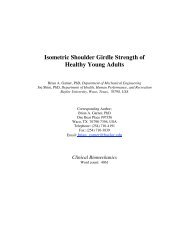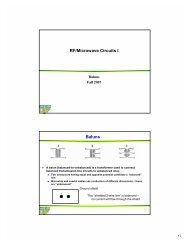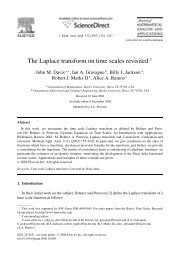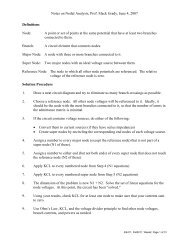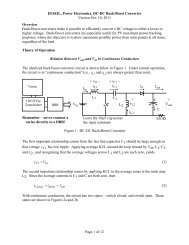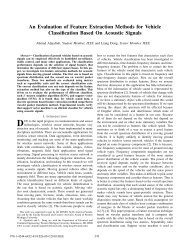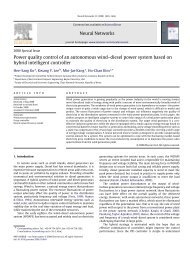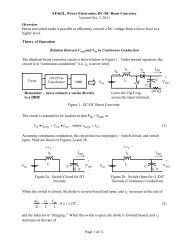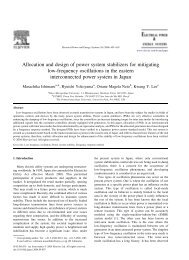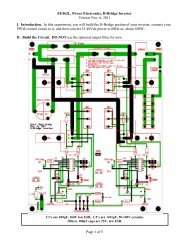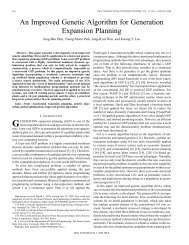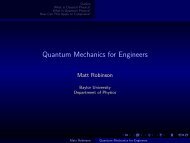A Self-Organizing Power System Stabilizer using ... - IEEE Xplore
A Self-Organizing Power System Stabilizer using ... - IEEE Xplore
A Self-Organizing Power System Stabilizer using ... - IEEE Xplore
You also want an ePaper? Increase the reach of your titles
YUMPU automatically turns print PDFs into web optimized ePapers that Google loves.
442 <strong>IEEE</strong> Transactions on Energy Conversion, Vol. 11, No. 2, June 1996<br />
A <strong>Self</strong>-organizing <strong>Power</strong> <strong>System</strong> <strong>Stabilizer</strong> <strong>using</strong> Fuzzy Auto-Regressive<br />
Moving Average (FARMA) Model<br />
Young-Moon Park, Senior Member, <strong>IEEE</strong><br />
Un-Chul Moon, Student Member, <strong>IEEE</strong><br />
Electrical Engineering Department<br />
Seoul National University<br />
Seoul 15 1-742, Korea<br />
Kwang Y. Lee , Senior MemberJEEE<br />
Electrical Engineering Department<br />
The Pennsylvania State University<br />
University Park, PA 16802, U.S.A.<br />
Abstract - This paper presents a self-organizing power system<br />
stabilizer (SOPSS) which use the fuzzy Auto-Regressive Moving<br />
Average (FARMA) model. The control rules and the<br />
membership functions of proposed the fuzzy logic controller are<br />
generated automatically without <strong>using</strong> any plant model. The<br />
generated rules are stored in the fuzzy rule space and updated<br />
on-line by a self-organizing procedure. To show the effectiveness<br />
of the proposed controller, comparison with a conventional<br />
controller for one-machine infinite-bus system is presented.<br />
1. INTRODUCTION<br />
The high complexity and nonlinearity of power systems<br />
have created a great deal of challenge to power system<br />
control engineers for decades. One of the most important<br />
problems in power systems is the damping of low-frequency<br />
oscillation. If no adequate damping is available, the<br />
oscillations may be sustained for minutes and grow to cause<br />
system separation [ 1],[2].<br />
Many kinds of stabilizers have been proposed to improve<br />
the stability of synchronous generators. The gain settings of<br />
power system stabilizers (PSS) are usually fixed at a certain<br />
set of values which are determined based on a nominal<br />
operating point [ 11-[5]. These fixed gain controllers are<br />
96 WM 037-2 EC A paper recommended and approved by the <strong>IEEE</strong> Energy<br />
Development and <strong>Power</strong> Generation Committee of the <strong>IEEE</strong> <strong>Power</strong><br />
Engineering Society for presentation at the 1996 <strong>IEEE</strong>/PES Winter Meeting,<br />
January 21-25, 1996, Baltimore, MD. Manuscript submitted July 19, 1995;<br />
made available for printing January 4, 1996.<br />
always a compromise between the best settings for light and<br />
heavy load conditions. It is impossible for these fixed gain<br />
stabilizers to maintain the best damping performance when<br />
there is a drastic change in system operating condition, such<br />
as that resulting from a three-phase fault in power system. In<br />
order to overcome this difficulty, a self-tuning stabilizer,<br />
where the gain settings are adjusted in real time to<br />
automatically track the variations in the operating condition,<br />
was employed [6],[7].<br />
As an alternative to these controls, the concept of fuzzy<br />
logic was introduced by Zadeh [8], and since its introduction<br />
by Mamdani [9], the Fuzzy Logic Control (FLC) method has<br />
been successfully applied to various control problems<br />
[14],[15]. Hassan, Malik and Hope applied it to PSS design.<br />
[lo]. In this method, the output stabilizing signal was<br />
calculated based on the representation of the alternator state<br />
in the phase plain. Ramaswamy, Edwards, and Lee proposed<br />
an automatic tuning method for a FLC and applied it to<br />
control a nuclear reactor [l 11. In this method, the rules were<br />
parameterized as functions of fuzzy input variables and the<br />
parameters were tuned off-line through experiments.<br />
Recently, Hiyama, Kugimiya and Satoh proposed a PID type<br />
fuzzy logic PSS [12]. They took into account the PID<br />
information of the generator speed. Additional parameters<br />
were also tuned off-line to minimize the performance index.<br />
In this paper, the self-organizing fuzzy logic controller<br />
(SOFLC) proposed in [13], which was named as Fuzzy Auto-<br />
Regressive Moving Average (FARMA) controller, is<br />
modified to enhance the low frequency damping of a<br />
synchronous machine. In [13]1, we proposed a complete<br />
design method for an on-line SOFLC without <strong>using</strong> any plant<br />
model. In the conventional FLC, the rule base and<br />
membership functions are supplied by an expert or tuned offline<br />
through experiment^ However, the FARMA FLC needs<br />
no expert in making control rules. Instead, rules are<br />
generated <strong>using</strong> the history of input-output pairs, and new<br />
inference and defuzzification methods are developed. The<br />
0885-8969/96/$05.00 0 1996 <strong>IEEE</strong>
443<br />
generated rules are stored in the fuzzy rule space and updated<br />
on-line by a self-organizing procedure.<br />
Characteristics of the FARh4A FLC algorithm are discussed<br />
in this paper from the point of view of its applicability to<br />
PSS. A modified form of FARMA FLC which is more<br />
suitable for PSS is developed and presented.<br />
11. BRIEF REVIEW OF FARMA FLC [ 131<br />
A. DeJinition of the FARMA Rule<br />
In general, the output of a system can be described with a<br />
function or a mapping of the plant input-output history. For a<br />
single-input single-output (SISO) discrete-time system, the<br />
mapping can be written in the form of a nonlinear autoregresisive<br />
moving average (NARMA) as follows:<br />
where y(k) and u(k) are respectively the output and input<br />
variables at the k-th time step.<br />
The objective of the control problem is to find a control<br />
input sequence which will drive the system to an arbitrary<br />
reference set point yIeF Rearranging (1) for control purpose,<br />
the value of the input U at the k-th step that is required to yield<br />
the reference output yref can be written as follows:<br />
which is viewed as an inverse mapping of (1).<br />
The proposed controller doesn't use rules pre-constructed by<br />
experts, but forms rules with input and output history at every<br />
sampling step. The rules generated at every sampling step are<br />
stored in a rule base, and updated as experience is<br />
accumulated <strong>using</strong> a self-organizing procedure.<br />
The system (1) yields the last output value y(k+l) when the<br />
output and input values, y(k), y(k- l), y(k-2), ..*, u(k), u(k- I),<br />
u(k-2), ..., are given. This implies that u(k) is the input to be<br />
applied when the desired output is yref as indicated explicitly<br />
in (2). Therefore, a FARMA rule with the input and output<br />
history is defined as follows:<br />
IFYrefis Ali, y(k) is A2i, y(k-1) is A3i, ..., y(k-n+l) is A(,+iy<br />
AND u(k-I) is Bli, ~(k-2) is B2i ,..., u(k-m) is B,i,<br />
THEN u(k) is Ci, (for the i-th rule) (3)<br />
where, n, m : number of output and input variables<br />
Aij, Bij : antecedent linguistic values for the i-th rule<br />
Ci : consequent linguistic value for the i-th rule.<br />
The rule (3) is generated at (k+l) time step. Therefore, y(k+l)<br />
is given value at &+I) step. The rule (3) explaines that " If<br />
desired yref is y(k+l) with given input-output history, y(k),<br />
y(k-l), y(k-2), -., u(k), u(k-I), u(k-2), -.., THEN u(k) is the<br />
input to be applied".<br />
In a conventional FLC, an expert usually determines the<br />
linguistic values Ai+ Bij, and Ci by partitioning each universe<br />
of discourse, and the formulation of fuzzy logic control rules<br />
is achieved on the basis of the expert's experience and<br />
knowledge. In this paper, however, these linguistic values are<br />
determined from the crisp values of the input and output<br />
history at every sampling step. Therefore, at the initial stage,<br />
the assigned u(k) may not be a good control, but over time,<br />
the rule base is updated <strong>using</strong> the self-organizing procedure,<br />
and better controls are applied.<br />
A fuzzification procedure for fuzzy values of (3) is<br />
developed to determine A,,, -., A(,+,),, Bli, B2i , ..., Bmi,<br />
and Ci from the crisp y(k+ l), y(k), y(k-1), -a,<br />
y(k-n+l), u(k-<br />
I), u(k-2), ..., u(k-m), and u(k), respectively. The fuzzification<br />
is done with its base on a reasonably assumed input or output<br />
ranges. When the assumed input or output range is [a, b], the<br />
membership function for crisp x1 is determined in a triangular<br />
shape as follows:<br />
l o else<br />
l+(x-xl)/(b-a) if alx
444<br />
result of this inference, the net control range (NCR) is<br />
determined as a subset [p, q] of [a, b] with the constant<br />
membership value a.<br />
Defuzzification is a procedure to determine a crisp value<br />
from a consequent fuzzy set (C,). In FARMA controller,<br />
defuzzification is to determine a crisp value from the net<br />
control range (NCR) resulting from the inference. The NCR is<br />
modified to compute a crisp value by <strong>using</strong> the prediction or<br />
"trend" of the output response. The series of the last outputs is<br />
extrapolated in time domain to estimate y(k+l) by the Newton<br />
backward-difference formula. If the extrapolation order is I,<br />
the estimate 9 (k+l) is calculated as follows:<br />
1<br />
i=O<br />
Defuzzification is performed by comparing the two values,<br />
the estimate 9 (k+l) and the reference output yref or the<br />
temporary target yr(k+l), generated by<br />
(7)<br />
yr(k+l) = ~ (k) + a (Yref- ~(k)), (8)<br />
where a is the target ratio constant (0 < a 5 1). The value of a<br />
describes the rate with which the present output y(k)<br />
, approaches the reference output value, and thus has a positive<br />
value between 0 and 1. 'The value of a is chosen by the user to<br />
obtain a dep:rable response.<br />
When the :stimate exceeds the reference output, the control<br />
has to slow down. On the other hand, when the estimate has<br />
not reached the reference, the control should speed up. To<br />
modi@ the control range, the sign of Vu(k) (= u(k)-u(k-1)) is<br />
assumed to be the same as the sign of (yr(k+l)-jj(k+l))<br />
without the loss of generality.<br />
Thus, for the case of yr(k+l) > 9 (k+l), hence the sign of<br />
Vu(k), is positive, u(k) has to be increased from the previous<br />
input u(k-1). On the other hand, when the sign of Vu(k) is<br />
negative and u(k) has to be decreased from the previous input<br />
u(k-1). The final crisp control value u(k) is then selected as<br />
one of the mid-points of the modified net control ranges as<br />
follows:<br />
(u(k- I)+q) / 2 for y,(k + I)> 9(k +I),<br />
u(k) =<br />
(9)<br />
{ (p + u(k- I))/ 2 for y,(k+ I) < y(k + 1).<br />
where p and q are the respective lower and upper limits of the<br />
net control range (NCR) resulting from the inference.<br />
(n+m+l)-dimensional rule space, i.e., (xli, x ~ ... ~ , x , (~+~+~)~).<br />
To update the rule base, the following performance index is<br />
defined:<br />
J = /Y,(k+l) - Y(k+l)/, (10)<br />
where y(k+l) is the real plant output, and y,(k+l) is the<br />
reference output. Therefore, at the (k+l)-th step, the<br />
performance index J is calculated with the real plant output<br />
y(k+l) resulting from the k-th step control.<br />
The fuzzy rule space is partitioned into a finite number of<br />
domains and only one rule, i.e., a point, is stored in each<br />
domain. If there are two rules in a given domain, the selection<br />
of a rule is based on J. That is, if there is a new rule which has<br />
the output closer to the reference output in a given domain,<br />
the old rule is replaced by the new one. The self-oiganization<br />
of the rule base, in other words "learning" of the object<br />
system, is performed at each sampling time, Fig. 1. In Fig. 1,<br />
the reference model block represents (8).<br />
Yrei<br />
a<br />
_. --<br />
Inference<br />
Fuzzify<br />
Fig. 1. The FARMA control system architecture<br />
111. SELF-ORGANIZING POWER SYSTEM STABILIZER<br />
A. <strong>Power</strong> <strong>System</strong> Model<br />
The purpose of this paper is to demonstrate the selforganizing<br />
feature of the SOPSS when there is no<br />
mathematical model, either on the generator nor on the<br />
power system to which the machine is connected. The"<br />
Synchronous<br />
Generator<br />
I-<br />
I<br />
Vt Z R1+jX VO<br />
C. Se'elf-Organization ofthe Rule Base<br />
The FARMA rule defined in Section A is generated at every<br />
sampling time. Each rule can be represented as a point in the<br />
Fig. 2. A 0n.e-machine, infinite-bus power system
B. <strong>Self</strong>-organizing <strong>Power</strong> <strong>System</strong> <strong>Stabilizer</strong><br />
-.a<br />
Fig. 3. A linearized one-machine, infinite bus model<br />
Table 1. Constants of one-machine, infinite-bus model<br />
Generator<br />
Constants<br />
Exciter Constants<br />
Line Constants<br />
Initial Constants<br />
M= 9.26, D= 0, T,,'= 7.76<br />
X ~ Z 0.973, ~d'= 0.19, xq= 0.55<br />
K,= 50, TA= 0.05<br />
R1=-0.051, XI= 1.49, R2=-0.102<br />
X2 = 2.99, G = 0.249, B= 0.262<br />
P,,= 1.0, Qeo= 0.015, V,,= 1.05<br />
It is noted the system has a non-minimum phase zero and a<br />
zero at the origin. The FARMA FLC can be interpreted as a<br />
kind of inverse model trainer by (2). However, it is well<br />
known that the non-minimum phase zero plant can't be<br />
controlled by pole-zero cancellation because of the internal<br />
instability. In other words, the control value U, can diverge<br />
in order to maintain the Am to zero. Moreover, the system has<br />
a zero at the origin, which means U, is not unique in the'<br />
steady state. It is recommended the steady state control value,<br />
U,, of PSS be zero since it is a supplementary control.<br />
Therefore, a modification of the FARMA FLC is necessary to<br />
prevent the divergence and non-zero steady state value of U,.<br />
To overcome these problems, we directly limit the control<br />
value according to the output error as follows:<br />
SOPSS will be learning the system from the input-output data<br />
as it stabilizes the unknown system. Consequently, the<br />
SOPSS will be adapive from system to system, from one<br />
operating condition to another operating condition. For<br />
illustration purpose, the system considered in this paper is a<br />
synchronous generator connected to an infinite bus through<br />
two transmission lines, Fig. 2. During low frequency<br />
oscillations, the linearized model can be drawn as Fig. 3 [2].<br />
For the calculation of constants - K ~ the , initial currents,<br />
voltages and torque angle of the system in a steady state must<br />
be known. These initial values are found from a load flow<br />
study. Since the real system is nonlinear, the parameters<br />
K~ - p(, are changed with the load and the system conditions.<br />
However, for demonstration purpose, we select few operating<br />
conditions for the linearized model.<br />
Table 1 shows the values of system parameters. The<br />
negative RI and R2 stem from deriving the one-machine,<br />
infinite bus model for a multimachine system by<br />
equivalencing smaller generators by equivalent impedances<br />
with negative resistances. Without supplementary excitation,<br />
the system is unstable and has a non-minimum phase zero<br />
and a zero at the origin.<br />
The supplementary control U, is applied through the<br />
T,, and K~ blocks in Fig. 3 to obtain the extra damping<br />
AT, in Fig. 3. Since it is a linearized model, a conventional<br />
PSS as a phase lead compensation is included by the<br />
superposition principle. If Am is the control input, the control<br />
including the reset block becomes as follows [2]:<br />
where, uyk) : modified control value,<br />
K : feedback constant,<br />
u(k) : control value of FARMA FLC.<br />
In (12), yref is the reference output, i. e., zero for speed<br />
deviation in this paper. Then, the modified control value is<br />
decreased with the output error (yref - y(k)). Moreover, in<br />
steady state it always becomes zero.<br />
Fig. 4 shows the modification of the FARMA FLC for<br />
PSS. The plant input U' is U, and the output y is Am as in the<br />
conventional method. The plant output and input values,<br />
y(k + 1). y(k), . .') y(k - 3), u'(k), . . .,u'(k - 3) are used to form the<br />
FARMA rule. The target ratio constant a and feedback<br />
constant K are chosen by off-line. The sampling time is 0.02<br />
sec. The proposed FARMA PSS doesn't assume a plant<br />
model, instead it learns the behavior of the plant by inputoutput<br />
history. Therefore, it can cope with unexpected load<br />
conditions and faults.<br />
I<br />
I 1<br />
Fig. 4. The <strong>Self</strong>-organizing <strong>Power</strong> <strong>System</strong> <strong>Stabilizer</strong><br />
i<br />
I
446<br />
IV. SIMULATION RESULTS<br />
After setting the parameters for the conventional PSS and<br />
the SOPSS, we consider four disturbances in simulations.<br />
According to each disturbance, the plant parameters are<br />
changed. To compare the closed loop chracteristics of two<br />
systems, it is assumed that small torque angle deviations ( ~6)<br />
are suddenly applied at 0 sec. for each disturbance.<br />
A. Case I: Normal Loud Condition<br />
Figs. 5 and 6 show the speed deviations of the conventional<br />
PSS and the SOPSS, respectively. It is assumped that initial<br />
torque angle deviations(A6) at 0 sec. are 0.06, 0.08 and 0.1<br />
[radian] for a, b and c, respectively. The rising times are<br />
similar, but the speed deviations of the SOPSS show smaller<br />
overshoots and settling times than those of the conventional<br />
method.<br />
B. Case 2: Heavy Loud Condition<br />
In case B, we consider different operating condition, i.e.,<br />
the real power P is increased to 1.3 from 1. Figs. 7 and 8<br />
show the speed deviations of the conventional PSS and the<br />
SOPSS, respectively. The initial torque angle deviations ( ~ ) 6<br />
are 0.06, 0.08 and 0.1 for a, b and c, respectively. Because<br />
the conventional controller is designed for the normal<br />
operating condition, the overshoots and the settling times are<br />
increased somewhat than those in case A. On the contrary,<br />
the undershoots and overshoots, in the case of SOPSS, are<br />
improved from case A. This is because the SOPSS doesn't<br />
assume any operating condition; instead, it constructs the rule<br />
base of the system by on-line adaptation.<br />
C. Case 3: isolation of a Transmission Line<br />
In this case, transmission line 2 in Fig. 2 is isolated with<br />
normal load condition. The isolation of line 2 may result<br />
from three-phase fault or three-phase to ground fault, etc. To<br />
simulate this case, the 2 2 is removed, and Y is changed in<br />
Fig. 2 accordingly. Figs. 9 and 10 show the speed deviations<br />
of the conventional PSS and the SOPSS, respectively. The<br />
initial torque angle deviations are 0.06, 0.08 and 0.1 for a, b<br />
and c, respectively. The settling times of the conventional<br />
PSS are increased to almost 7 sec. On the other hand, the<br />
SOPSS shows no significant difference from cases A and B.<br />
D. Case 4: Different Inertia Constanl<br />
Here, we consider different inertia constant for the<br />
synchronous generator with normal load condition. The<br />
purpose of this case is to consider the modeling error of the<br />
synchronous generator. That is, the real values can be either<br />
7, 9.26 or 12, respectively, while the assumed value is 9.26 in<br />
the model. Figs. 1 I and 12 show the speed deviations of the<br />
conventional PSS and the SOPSS, respectively. The inertia<br />
-1. 2<br />
--I timersec]<br />
0 1 2 3 4 5 6 7 8 ' 3<br />
Fig. 5. Conventional PSS. (case 1: normal load)<br />
[pu*O.OOl]<br />
0. a<br />
1<br />
-1 2c 0 ; 2 3 4 5 6 7 rT! timeIsec1<br />
Fig. 8. <strong>Self</strong>-organizing PSS. (case 2: heavy load)
441<br />
[pu*0.001]<br />
constants are 7, 9.26 and 12 for a, b and c, respectively. The<br />
initial torque angle deviation(A6) is 0.1. When the real<br />
inertia constant is 12, the setling time of the conventional<br />
PSS is increased to 6 sec (c of Fig. 11). On the other hand,<br />
the SOPSS shows no significant difference.<br />
V. CONCLUSIONS<br />
Development of a self-organizing a power system stabilizer<br />
(SOPSS) was described in this paper. The SOPSS doesn't use<br />
any plant model or pre-constructed rule base of an expert.<br />
Instead, the control rules are generated automatically with the<br />
input-output history, and the rule base is updated on-line.<br />
Simulations considered normal and heavy loads, isolation of<br />
a transmission line, and different inertia constants for the<br />
synchronous generator. Compared with the conventional<br />
PSS, the SOPSS showed better performance. Especially, the<br />
SOPSS maintained good performance for different operating<br />
conditions, indicating adaptation and robustness properties.<br />
However, simulation shows a similar stability margin for<br />
both conventional PSS and SOPSS. Therefore, this behavior<br />
has to be studied more.<br />
-l. k i i i i i i i i d time[secl<br />
Fig. 10. <strong>Self</strong>-organizing PSS. ( case 3: transmission loss)<br />
VI. ACKNOWLEDGMENT<br />
[pu*o.001]<br />
0. 8<br />
0.<br />
0.<br />
0.<br />
Am<br />
-0.<br />
-0.<br />
I<br />
The work is supported in parts by Korea Science and<br />
Engineering Foundation (KOSEF) and the National Science'<br />
Foundation (NSF) under grants "U.S.-Korea Cooperative<br />
Research on Intelligent Distributed Control of <strong>Power</strong> Plants<br />
and <strong>Power</strong> <strong>System</strong>s" (INT-9223030), and "Research and<br />
Curriculum Development for <strong>Power</strong> Plant Intelligent<br />
Distributed Control" (EID-92 1232).<br />
-1. 2<br />
[pu*0.001]<br />
0.8<br />
-1. 2<br />
Fig. 1 1. Conventional PSS. ( case 4: modeling error)<br />
Fig. 12. <strong>Self</strong>-organizing PSS. (case 4: modeling error)<br />
I<br />
VII. REFERENCE<br />
[l] P. M. Anderson and A. A. Fouad, <strong>Power</strong> <strong>System</strong> Control<br />
and Stability, <strong>IEEE</strong> Press, 1994.<br />
[2] Y. N. Yu, Electric <strong>Power</strong> <strong>System</strong> Dynamics, Academic<br />
Press, 1983.<br />
[3] F. P. de Mello and C. A. Concordia, "Concepts of<br />
Synchronous Machine Stability as Affected by Excitation<br />
Control", <strong>IEEE</strong> Trans. on PAS, vol. 88, no. 4, pp. 316-<br />
329, April 1969.<br />
[4] R. J. Fleming, M. A. Mohan and K. Parvatisam,<br />
"Selection of Parameters of <strong>Stabilizer</strong>s in Multimachine<br />
<strong>Power</strong> <strong>System</strong>s", <strong>IEEE</strong> Trans. on PAS, vol. 100, no. 5,<br />
pp. 2329-2333, May 1981.<br />
[5] T. L. Huang, T. Y. Hwang and T. Yang, "Two-Level.<br />
Optimal Output Feedback <strong>Stabilizer</strong> Design", <strong>IEEE</strong><br />
Trans. on PWRS, vol. 6, no. 3, August 1991.
448<br />
[6] A. Ghosh, G. Ledwich, 0. P. Malik and G. S. Hope,<br />
"<strong>Power</strong> <strong>System</strong> <strong>Stabilizer</strong> based on Adaptive Control<br />
Technique", <strong>IEEE</strong> Trans. on PAS, vol. 103, no. 8, pp.<br />
1983- 1989, August 1984.<br />
[7] C. J. We and Y. Y. Hsu, "Design of <strong>Self</strong>-Tuning PID<br />
<strong>Power</strong> <strong>System</strong> <strong>Stabilizer</strong> for Multimachine <strong>Power</strong><br />
<strong>System</strong>", <strong>IEEE</strong> Trans. on PWRS, vol. 3, no. 3, August<br />
1988.<br />
[8] L. A. Zadeh, "Fuzzy Sets", Inform. Contr., vol. 8, pp.<br />
338-353, 1965.<br />
[9] E. H. Mamdani and S. Assilian, "An experiment in<br />
linguistic synthesis with a fuzzy logic controller", Int. J.<br />
Man Mach. Studies, vol. 7, no. 1, pp. 1- 13. 1975.<br />
[ 101 M. A. M. Hassan, 0. P. Malik and G. S. Hope, "A Fuzzy<br />
Logic Based <strong>Stabilizer</strong> for a Synchronous Machine",<br />
<strong>IEEE</strong> Trans. on Energy Conversion, vol. 6, no. 3, pp.<br />
407-413, 1991.<br />
[Ill P. Ramaswamy, R. M. Edwards, and K. Y. Lee, "An<br />
automatic tuning method of a fuzzy logic controller for<br />
nuclear reactors", <strong>IEEE</strong> Trans. Nuclear Science, vol. 40,<br />
no. 4, pp. 1253-1262, August 1993.<br />
[ 121 T. Hiyama, M. Kugimiya and H. Satoh, "Advanced PID<br />
type Fuzzy Logic <strong>Power</strong> <strong>System</strong> <strong>Stabilizer</strong>", <strong>IEEE</strong> Trans.<br />
on Energy Conversion, vol. 9, no. 3, pp. 514-520, 1994.<br />
[13] Y. M. Park, U. C. Moon and K. Y. Lee, It A <strong>Self</strong>-<br />
<strong>Organizing</strong> Fuzzy Logic Controller for dynamic systems<br />
<strong>using</strong> a Fuzzy Auto-Regressive Moving<br />
Average(FARMA) Model", <strong>IEEE</strong> Trans. on Fuzzy<br />
<strong>System</strong>s, vol. 3, no. 1, February, pp. 75-82, 1995.<br />
[14] W. Pedrycz, Fuzzy Control and Fuzzy <strong>System</strong>s, John<br />
Wiley & Sons, 1989.<br />
[15] B. Kosco, Neural Network and Fuzzy <strong>System</strong>s,<br />
Englewood Cliffs, Prentice-Hall, 1992.<br />
interests include fuzzy logic systems, artificial neural<br />
networks, and their applications to control, operation, and<br />
planning of power systems.<br />
Kwang Y. Lee received the B.S. degree in electrical<br />
engineering from Seoul National University, Seoul, Korea, in<br />
1964, the M.S. degree in electrical engineering from North<br />
Dakota State University, Fargo, ND, in 1967 and the Ph.D.<br />
degree in system science from Michigan State University,<br />
East Lansing, MI, in 1971. He has been on tne faculties of<br />
Michigan State, Oregon State, University of Houston, and the<br />
Pennsylvania State University, University Park, PA, where<br />
he is a Professor of Electrical Engineering. His current<br />
research interests include control theory, artificial neural<br />
networks, fuzzy logic systems, and computational inteligence'<br />
and their applications to power systems. Dr. Lee is a senior<br />
member of <strong>IEEE</strong>.<br />
VIII. BIOGRAPHY<br />
Young-Moon Park was born in Masan, Korea on Aug. 20,<br />
1933. He received his B.S., M.S., and Ph.D. in electrical<br />
engineering from Seoul National University in 1956, 1959<br />
and 197 1, respectively in electrical engineering. His major<br />
research field includes power system operation and control,<br />
and artificial intelligence applications to power systems.<br />
Since 1959, he has been a faculty of Seoul National<br />
University where he is currently a Professor of Eletrical<br />
Engineering. He is also serving as the president of the<br />
Electrical Engineering and Science Research Institute. Dr.<br />
Park is a senior member of <strong>IEEE</strong>.<br />
Un-Chul Moon received the B.S. and M.S. degrees in<br />
electrical engineering from Seoul National University, Seoul,<br />
Korea, in 1991 and 1994, respectively. He is currently a<br />
Ph.D. candidate in <strong>Power</strong> <strong>System</strong> Laboratory, Electrical<br />
Engineering, Seoul National University. His current research



